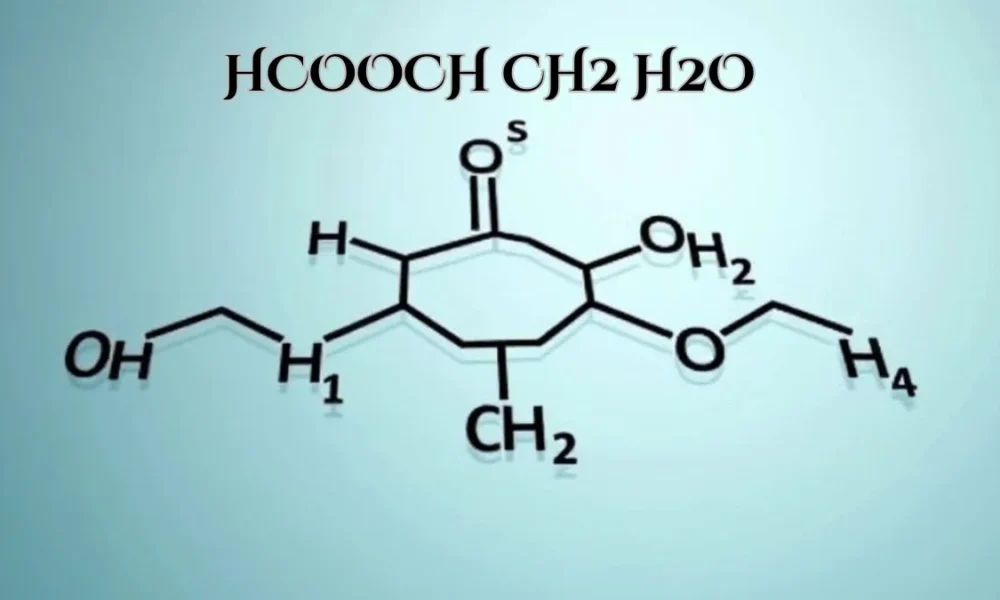In the world of organic chemistry, shorthand notations are commonly used to represent complex reactions and compounds. One such curious expression is “hcooch ch2 h2o”, which at first glance may appear cryptic, but relates to an interesting reaction pathway involving esters, aldehydes, and water. In this article, we’ll break down what hcooch ch2 h2o might represent, its possible interpretation, and where it applies in both academic and industrial chemistry.
Breaking Down the Keyword: hcooch ch2 h2o
To understand the expression “hcooch ch2 h2o”, let’s try to decode the chemical components embedded in it:
-
HCOOCH likely refers to methyl formate or a related formate ester.
-
CH2 generally represents a methylene group, which could signify a connection or a bridging carbon.
-
H2O is, of course, water, a universal solvent and a reactant in many hydrolysis reactions.
Put together, hcooch ch2 h2o appears to represent a hydrolysis reaction or a potential transformation involving formate esters and water, possibly with an intermediate involving a CH2 group.
Possible Interpretation of hcooch ch2 h2o
One possible chemical reaction this phrase hints at is the acid- or base-catalyzed hydrolysis of a compound like methyl formate (HCOOCH3) in the presence of water. In such a case:
HCOOCH3 + H2O → HCOOH + CH3OH
However, when the term CH2 is included, it may suggest a bridge or substitution, such as a methylene-inserted ester, like:
HCOOCH2CH3 (ethyl formate)
Thus, hcooch ch2 h2o might be a shorthand way to represent a formate ester reacting with water, possibly leading to formic acid and alcohol as hydrolysis products.
Importance of the Reaction
Understanding such hydrolysis reactions is crucial in:
-
Pharmaceutical synthesis
-
Biodegradable plastics development
-
Flavor and fragrance chemistry
-
Biochemical pathways involving esterases
The hcooch ch2 h2o reaction, though informal in notation, represents a significant chemical transformation with wide-ranging applications.
Educational Significance
This phrase also underscores how students and chemists often use abbreviated forms like hcooch ch2 h2o in classroom settings, lab notes, and quick drafts. Learning to interpret such shorthand notations builds analytical thinking and practical chemical understanding.
Industrial Applications of hcooch ch2 h2o
In industrial chemistry, the breakdown or hydrolysis of esters like those represented in hcooch ch2 h2o is a foundational process. These reactions are commonly used in:
1. Solvent Production
Hydrolysis of methyl or ethyl formate produces formic acid and methanol or ethanol, both of which serve as valuable solvents in industrial processes.
2. Polymer Chemistry
Esters with CH2 bridges, when broken down in the presence of water (as implied in hcooch ch2 h2o), can release reactive monomers or contribute to the formation of biodegradable plastics.
3. Green Chemistry
The transformation hinted at by hcooch ch2 h2o aligns with eco-friendly chemistry goals. Hydrolysis typically avoids harsh reagents and favors water as a reactant, making it a sustainable method for producing essential chemicals.
Biochemical Relevance of Reactions like hcooch ch2 h2o
In living systems, ester hydrolysis occurs naturally through enzymes known as esterases. These biological catalysts enable reactions similar to hcooch ch2 h2o to occur rapidly and under mild conditions. For example:
-
Fat digestion involves ester hydrolysis to break down triglycerides.
-
Detoxification in the liver often includes the hydrolysis of ester-based drugs into inactive metabolites.
Although the exact phrase hcooch ch2 h2o isn’t used in biological textbooks, the underlying chemical principles are critical to understanding metabolism and drug behavior.
Experimental Considerations
If you’re working with compounds related to hcooch ch2 h2o in the lab, here are some important experimental tips:
-
Catalyst Choice: Acidic conditions (e.g., HCl) or basic conditions (e.g., NaOH) can accelerate the hydrolysis process.
-
Temperature Control: Mild heating can improve yield without decomposing sensitive components.
-
Purification: Post-reaction, formic acid and alcohol products can be separated via distillation or extraction.
Proper safety protocols should always be followed, especially when handling volatile esters or acidic products.
How Students Can Learn from hcooch ch2 h2o
For chemistry students, understanding how to decode and interpret expressions like hcooch ch2 h2o can enhance problem-solving abilities. This example teaches:
-
How to deduce structures from abbreviations
-
How to balance chemical equations
-
How to relate shorthand to full organic reactions
Assignments involving this kind of expression push students to apply foundational principles rather than simply memorizing formulas.
Common Misunderstandings
Here are a few clarifications related to hcooch ch2 h2o:
-
It does not refer to a single named compound, but rather a shorthand chemical process.
-
CH2 does not necessarily mean a standalone molecule—it’s likely a group or connector in a larger molecule.
-
Water (H2O) in the context of this expression is a reactant, not a solvent alone.
Conclusion
Though hcooch ch2 h2o may appear as a vague or unconventional string of chemical components, it encapsulates the heart of organic chemistry, transforming molecules through hydrolysis, using water as a catalyst for change. This kind of expression is common in lab shorthand, chemistry forums, and study notes. With the right interpretation, such phrases can unlock understanding of real-world applications in manufacturing, pharmaceuticals, environmental chemistry, and biochemistry.
Whether you’re a student, educator, or industry professional, knowing how to interpret phrases like hcooch ch2 h2o provides a bridge between symbolic chemistry and real-world science.
